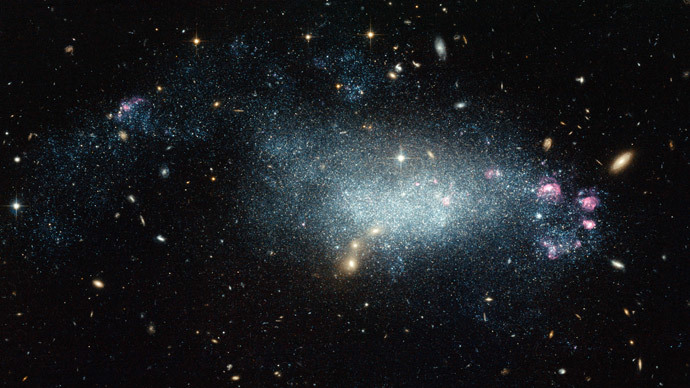www.aljazeerah.info
News, September 2014
Archives
Mission & Name
Conflict Terminology
Editorials
Gaza Holocaust
Gulf War
Isdood
Islam
News
News Photos
Opinion Editorials
US Foreign Policy (Dr. El-Najjar's Articles)
www.aljazeerah.info
|
Editorial Note: The following news reports are summaries from original sources. They may also include corrections of Arabic names and political terminology. Comments are in parentheses. |
Unique Organic Molecule Discovered in Deep Space
September 27, 2014

Unique organic molecule discovered in deep space
Russia TV, September 26, 2014 22:50
A new kind of organic molecule has been discovered in a giant gas cloud in interstellar space, indicating that more complex molecules – the very core building blocks of life – can potentially form outside of the Earth and even be widespread in space.
The analysis of a star-forming gas cloud some 27,000 light years away from Earth, published in the journal Science, detected an iso-propyl cyanide molecule with a unique structure that is common in life-forming molecules, such as amino acids.
While finding a simple organic chemical in space is nothing new, a carbon-bearing molecule with a branched structure has been discovered for the first time, indicating that biologically crucial molecules can form not only on Earth, but in deep space too.
“This detection suggests that branched carbon-chain molecules may be generally abundant in the ISM [interstellar medium],” the study’s abstract reads.
The scientists – Dr Arnaud Belloche of the Max Planck Institute for Radioastronomy and his colleagues – found the molecule in a gas cloud called Sagittarius B2 – the “star factory” near the center of the Milky Way where many new stars are formed.
The team used the 12 telescopes of the Atacama Large Millimeter/submillimeter Array (ALMA), in Chile, to make its observations.
“Amino acids on Earth are the building blocks of proteins, and proteins are very important for life as we know it. The question in the background is: is there life somewhere else in the galaxy?” Belloche told the BBC.
“Our goal is to search for new complex organic molecules in the interstellar medium,” he said.
And the evidence suggests their presence could actually be widespread.
“The enormous abundance of iso-propyl cyanide suggests that branched molecules may in fact be the rule, rather than the exception, in the interstellar medium,” stated Robin Garrod, an astrochemist at Cornell University and a co-author of the paper, according to astrobiology.com.
Previously discovered organic molecules, like vinyl alcohol and ethyl formate, all shared a major structural characteristic: the atom carbons they consist of are arranged in one, more or less, straight line. So the finding of iso-propyl cyanide – the largest and most complex molecule discovered to date – is significant according to a Cardiff university astronomy professor.
“There seems to be quite a lot of it, which would indicate that this more complex organic structure is possibly very common, maybe even the norm, when it comes to simple organic molecules in space,” Professor Matt Griffin, head of the school of physics and astronomy at Cardiff University said.
The finding is already a breakthrough, but what scientists really hope to discover is actual amino acids.
“It's a step closer to discovering molecules that can be regarded as the building blocks or the precursors… of amino acids,” Griffin said.
***
Share this article with your facebook friendsFair Use Notice
This site contains copyrighted material the
use of which has not always been specifically authorized by the copyright
owner. We are making such material available in our efforts to advance
understanding of environmental, political, human rights, economic,
democracy, scientific, and social justice issues, etc. We believe this
constitutes a 'fair use' of any such copyrighted material as provided for
in section 107 of the US Copyright Law. In accordance with Title 17 U.S.C.
Section 107, the material on this site is
distributed without profit to those
who have expressed a prior interest in receiving the included information
for research and educational purposes. For more information go to: http://www.law.cornell.edu/uscode/17/107.shtml.
If you wish to use copyrighted material from this site for purposes of
your own that go beyond 'fair use', you must obtain permission from the
copyright owner.
|
|
|
|
||
|
||||||


